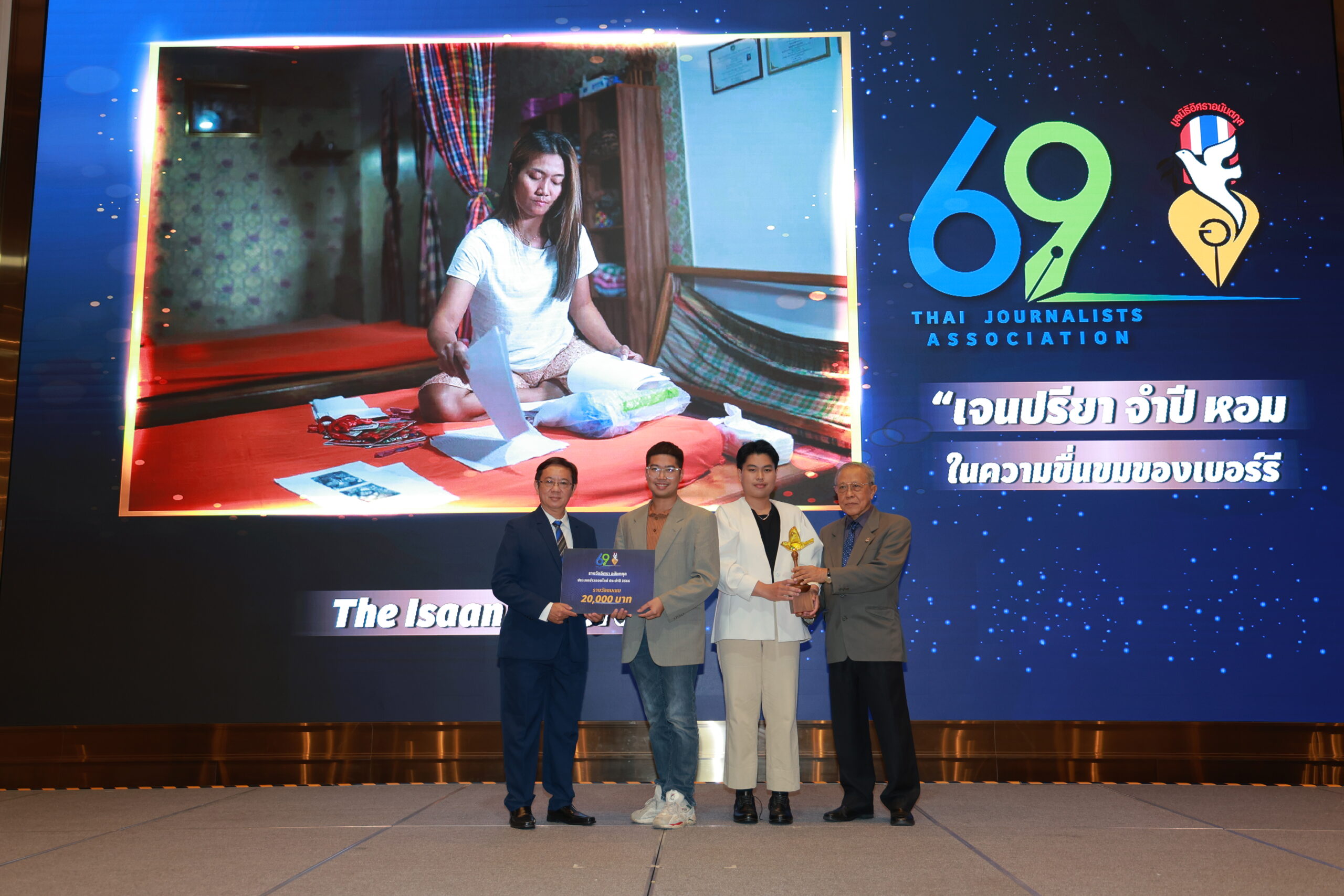
The Isaan Record and the Thai Democracy Advocates group arranged a screening of the movie “Cemetery of Splendour” in London to raise funds to recover the lost history of the “Holy Man Rebellion” in Isaan. When asked about the political situation in Thailand, the noted Thai independent direct Apichatpong Weerasethakul said he maintained the hope of seeing the new generation continued to push for reform of the Thai military and the monarchy.
By the Isaan Record
London – The Isaan Record, together with the Thai Democracy Advocates, a Thai student democracy activist group in the UK, yesterday organized an afternoon film screening of “Cemetery of Splendor,” directed by Apichatpong Weerasethakul at the Curzon Goldsmiths, University of London. The event, held before a mostly non-Thai audience of more than 100, was organized to help raise funds that would lead to a series of media outputs that would raise greater awareness of the “Holy Man Rebellion.”
Before the screening, a presentation of “A rebellion in Isaan” by David Streckfuss, an international expert at Thammasat University’s Faculty of Sociology and Anthropology and a consultant to the Isaan Record, explained via Zoom that Isaan, or the Northeast of Thailand, has no shared history as a region before 1900.
“The word ‘Isaan’ was given to the region by Bangkok. It means ‘the Northeast.’ Bangkok wanted to make sure its inhabitants understood where they stood in relation to Bangkok,” he said.
The scholar at Thammasat University said Isaan history has always been understood as part of Thai national history. But to be part of Thai history, or, rather perhaps, Bangkok history, to become equal citizens within Thailand, Isaan people had to be Thai-ified. Use of their languages was banned in schools. Their languages were downgraded into “local dialects.” Their ethnic identity was officially denied. They were not Lao, or Khmer, or Phuthai. They were all now “Thai.” They were invited to shed their local identities and embrace “Thainess.”
Streckfuss said that it appeared that Thainess held a promise that all citizens were to be considered as equally Thai. But Thainess was a ruse, a ruse of a kind of colonialism. In fact, the central Thai have maintained a kind of racism hidden within Thainess.

“The people of Isaan have not been treated equally. A World Bank study from 15 years ago showed that while Isaan makes up 34% of the country’s population, the region receives only 6% of government expenditures. Per capita, a person in Bangkok receives 24 times more of government expenditure than a person in Isaan,” Streckfuss said. “Isaan is merely an afterthought, a security concern. Promised equality, it does not receive equality.”
“Under democratic governments, [the Northeast] began to use its electoral muscle. But under dictatorship, under authoritarianism, it has been silenced. But the new generation has awakened Isaan and reminded Isaan people that they have been marginalized, overlooked, taken for granted.They are creating a new awareness of themselves–and their history.There is another history, hidden beneath Thai national history,” he said.

In the same session, Apichatpong explained the reason for making the film “Cemetery of Splendour” in Khon Kaen was because it was his hometown. “I cannot say that I know that much about Isaan because in schools we have always been fed by propaganda or narratives from the Central [Region] which is Bangkok. Many of you may never have been to Isaan. I would like to share with you a little bit of that. It’s a corner of my hometown.”
Apichatpong said he made “Cemetery of Splendour” after making his film “Uncle Boonmee,” the story of a man who could recall his past lives. This movie, he said, was shot in 2014, a period when it was “harder and harder to talk about truth in Thailand. There were many factors. For example, the king was ailing and power was shifting, disappearing, and also the military was always there.”
“You can sense this kind of sensibility and unpredictability,” Apichatpong said. “Books were banned and so on. At that time, I was thinking about home, a place that I had not visited for almost 20 years. When I went back to Khon Kaen just to visit my mom, I was thinking of doing something. I realized that I had not stayed that long.”
At the time, he said, he noticed “Things have changed a lot. I saw a lot of old things in my memory. I decided to dedicate this film as something like a goodbye or farewell film to home and also to the country because I did not actually see the way out for Thailand.”
He explained that when he was young in Isaan, “we had the policy from the government that if you are a kid, you live in a circle of home, temple, and school. So this film also showed a circle of this idea,” but changed it a little bit to “home, hospital, and temple.” The film, he said, “was a combination of three spaces that he wanted to mix together in memory as a farewell letter.”
“I imagined a place dominated by sleeping or dreaming,” Apitchatpong said. “When you are dreaming, you cannot face reality. Nobody can touch you so we planned that. Actually before the shooting [there was] was a military coup in May in 2014. We shot in August or September…so during the shooting time there was a sense even more of a present of something shaky. I asked a lot whether there was going to be some news that the military would do something or someone would die. These things [were] shown in the film, this kind of uncertainty and the darkness. It became my last long film in Thailand.”

After that there were some questions from participants in the theater. One question came from a Thai student who came from the Isaan area. He asked, “Do you think memories will be the theme that you want to continue working on as a film director in the future?”
Apichartpong answered that memory is not fixed and felt that by looking and thinking about memory it is not just only mine like the last film in Columbia is also to find something new in there, what we are doing today as well to look at memories in Isaan. It is to find something new. For me, coming from Thailand it is very important to really find out who I am. Because my identity is based on my education and belief and other things but then when you look at it and listen to other people. You will know that it is not what I think. That is a local and also national and global memory that we have. For me, the experience in Columbia was very rich. We’ve shared a lot of our beliefs, trauma and suffering. To learn is my studying point.
Another question came from a non-Thai student who asked that it has been a decade since the Red-shirts came out. What kind of state do you believe Thailand is in now, in terms of cultural awakeness?
Apichartpong responded by saying, “I have mixed feelings. It is like a person in love since last year and early this year. I was really in love because the love of hope that the young generation started by questioning and asking for military and monarchy reform. If you are following the news…I started to question just this month whether it is healthy” to continue following the events as the situation keeps “going up and down and then you think about global history and [see] how it is not easy. You will realize that what the students are doing is not really new. It is new in Thailand because we cannot imagine asking questions about the monarchy. But yet when you look at the big picture, you will see it is very very tough,” he said.
And yet, he added, “it is an exciting time to be here, in Thailand.
In front of the Curzon Cinema, Goldsmiths, University of London, there was also an exhibition to inform people of the political situation in Thailand. It included political activists who had been forcibly disappeared and those who had immigrated, arising from political demonstrations of students.
NOTE: Please donate to this worthy endeavor at Gofundme or Bangkok Bank, account 521-4-40594-5 of the Foundation of Isaan Education and Popular Media.




